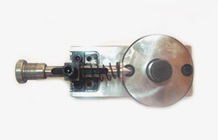





 Revolving Centre
Revolving Centre Dead Centre
Dead Centre Roller Cage
Roller Cage
In metalworking and woodworking, a jig is a type of tool used to control the location and/or motion of another tool. A jig's primary purpose is to provide repeatability, accuracy, and interchangeability in the manufacturing of products. A jig is often confused with a fixture; a fixture holds the work in a fixed location. A device that does both functions (holding the work and guiding a tool) is called a jig.
An example of a jig is when a key is duplicated, the original is used as a jig so the new key can have the same path as the old one.
Jigs or templates have been known long before the industrial age. There are many types of jigs, and each one is custom-tailored to do a specific job. Many jigs are created because there is a necessity to do so by the tradesmen. Some are to increase productivity, to do repetitious activities and to do a job more precisely. Because jig design is fundamentally based on logic, similar jigs used in different times and places may have been created independently.
----------------------------------------------------------------------------------------------------------------------------------------------------------------------------------------------------------------------------------------
 FIXTURES
FIXTURESA fixture is a workholding or support device used in the manufacturing industry. What makes a fixture unique is that each one is built to fit a particular part or shape. The main purpose of a fixture is to locate and in some cases hold a workpiece during either a machining operation or some other industrial process. A jig differs from a fixture in that it guides the tool to its correct position in addition to locating and supporting the workpiece.
The primary purposes of jigs and fixtures is to Reduce the cost of production
• Maintain consistent quality
• Maximize efficiency
• Enable a variety of parts to be made to correct specifications
Types of Fixtures: General Purpose - They are usually relatively inexpensive and can be used to hold a variety and range of sizes of workpieces
(examples: Vises, chucks, split collets).
Special Purpose - They are designed and built to hold a particular workpiece for a specific operation on a specific machine or process.